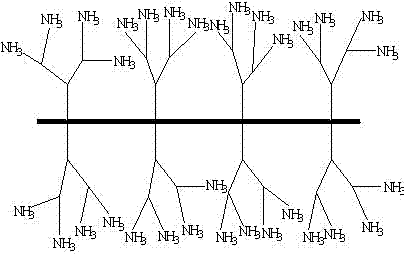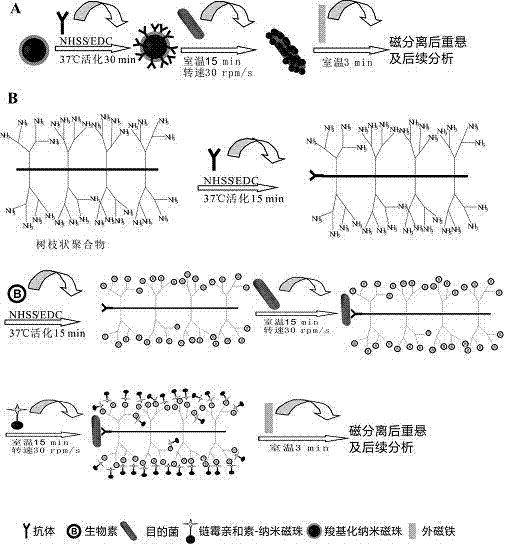Separation method of Streptococcus pneumoniae in complex matrix
A Streptococcus pneumoniae and complex matrix technology, applied in the biological field, can solve the problems of separation failure, high concentration of miscellaneous bacteria, complex matrix properties, etc., and achieve the effect of increasing the chance of contact, improving the separation efficiency, and shortening the separation time
- Summary
- Abstract
- Description
- Claims
- Application Information
AI Technical Summary
Problems solved by technology
Method used
Image
Examples
Embodiment 1
[0029] experiment one:
[0030] 1. The dendritic polymer-antibody complex is prepared according to the following steps:
[0031] (1) Dissolve 3.6 mg dendrimer aminated polyamide-amine dendrimer in 2 mL, 0.02 M, pH 6.5 PBS, add 0.6 mg NHSS, 0.4 mg EDC, place on a mixer at room temperature Stir and activate for 15 min;
[0032] (2) Take 10.5 mg SP The specific antibody was added to the above reaction solution, placed on a mixer at room temperature and stirred for 30 min;
[0033] (3) After the above solution was vacuum-dried, dissolved in deionized water, dialyzed in PBS and deionized water for 1 day; after the dialysis, the obtained solution was freeze-dried.
[0034] 2. The long-chain biotin-dendrimer-antibody complex is prepared according to the following steps:
[0035] (1) Dissolve 15 mg long-chain biotin, 3.6 mg NHSS, and 2.4 mg EDC in 2 mL 0.02 M pH 6.5 PBS buffer;
[0036] (2) Add 0.55 mg of dendrimer-antibody complex to the above solution, place it on a mixer at r...
Embodiment 2
[0040] Example 2 Enrichment effect experiment
[0041] (1) Take 1 mL of concentration as 10 4 cfu / mL Streptococcus pneumoniae in a 1.5 mL sterile centrifuge tube, centrifuge at 12,000 rpm for 5 min, discard the supernatant, and resuspend with an equal volume of sterile PBS solution.
[0042] (2) Enrichment and capture: Set up the technical solution group of the present invention (dendritic polymer group co-modified by Streptococcus pneumoniae antibody and long-chain biotin), nanomagnetic beads group modified by Streptococcus pneumoniae specific antibody, Streptococcus pneumoniae Specific antibody-modified micron magnetic bead group enriches target bacteria.
[0043] (3) After magnetic separation, pour the supernatant into a sterile centrifuge tube, and wash the isolated immunomagnetic beads with Streptococcus pneumoniae twice with PBST, mix well, and resuspend with 1 mL of sterile PBS solution Immunomagnetic bead complexes.
[0044] (4) Capture rate calculation: After grad...
Embodiment 3
[0057] Example 3 Enrichment capture experiment
[0058] Conventional magnetic stand separation time is 30min, and all the other are with embodiment 2.
[0059] The catch rate of each group is as follows:
[0060] Capture efficiency of micron magnetic bead set modified with specific antibody of Streptococcus pneumoniae Capture efficiency of nano-magnetic bead set modified with specific antibody of Streptococcus pneumoniae Capture efficiency of dendrimers co-modified with Streptococcus pneumoniae antibody and long-chain biotin 46.5% 40.6% 90.9%
[0061] The experimental results show that compared with the separation of 3min in Example 2, when the separation time reaches 30min, the capture efficiency of the three groups has been improved, especially the capture efficiency of the nano-magnetic bead group modified by the specific antibody of Streptococcus pneumoniae is the most obvious. This indicated that the capture efficiency of the magnetic nanobeads gr...
PUM
| Property | Measurement | Unit |
|---|---|---|
| particle diameter | aaaaa | aaaaa |
| particle diameter | aaaaa | aaaaa |
Abstract
Description
Claims
Application Information
 Login to View More
Login to View More - R&D
- Intellectual Property
- Life Sciences
- Materials
- Tech Scout
- Unparalleled Data Quality
- Higher Quality Content
- 60% Fewer Hallucinations
Browse by: Latest US Patents, China's latest patents, Technical Efficacy Thesaurus, Application Domain, Technology Topic, Popular Technical Reports.
© 2025 PatSnap. All rights reserved.Legal|Privacy policy|Modern Slavery Act Transparency Statement|Sitemap|About US| Contact US: help@patsnap.com


